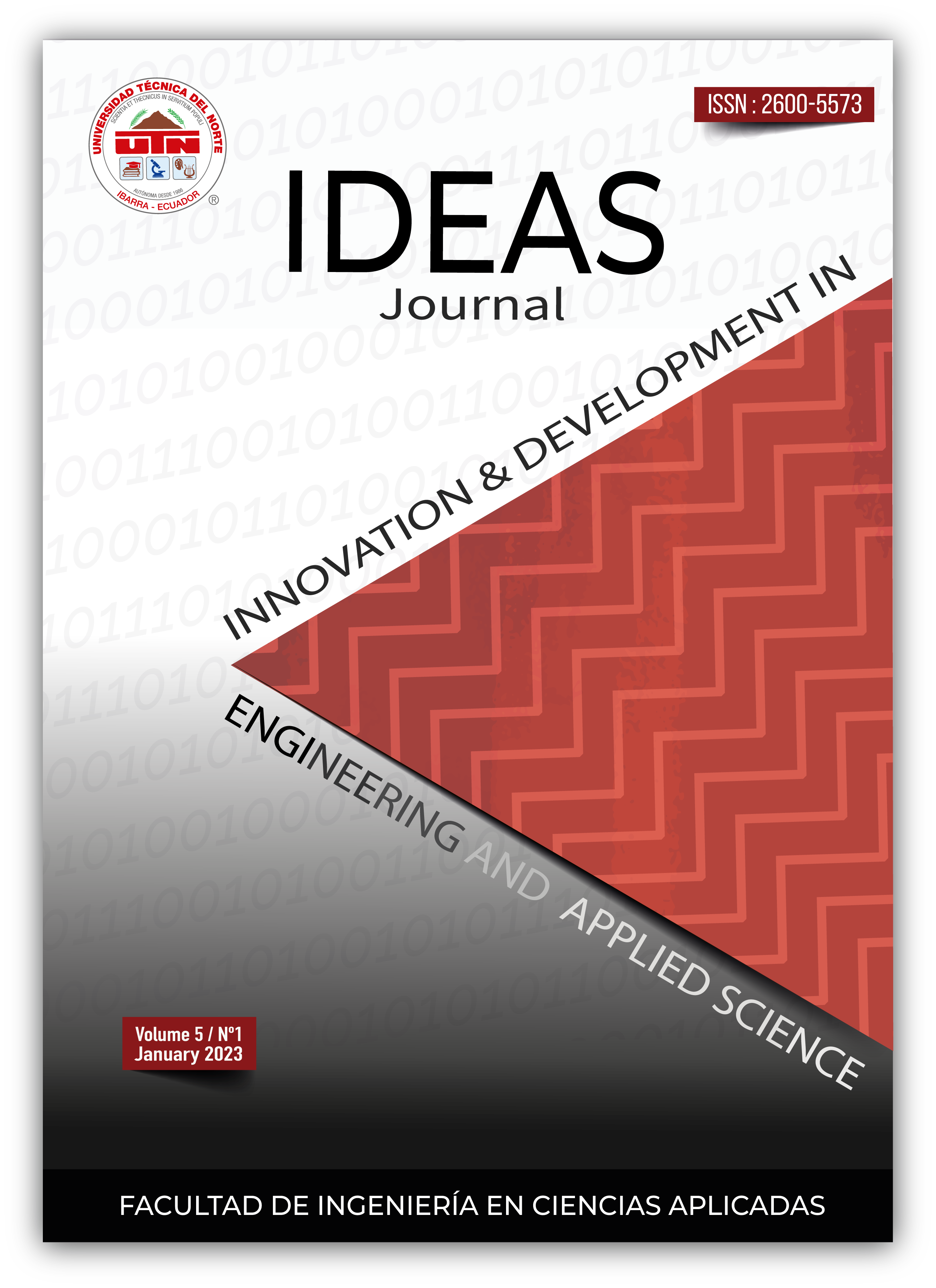Noise Pollution Control using Internet of Things (IoT) solutions
Main Article Content
Abstract
At present, noise is one of the main environmental pollutants that even government agencies are paying attention to find solutions for its control. Noise pollution traditional methods are based on expensive electronic devices—limited to constant monitoring in real-time. In recent years, (IoT), the internet of things diverse strategies, has been proposed to tackle this issue by offering low-cost sensors, capturing and storing real-time data for better decision-making processes. This article presents the results from an exploratory literature revision regarding Noise Pollution solution proposals based on IoT. in 17 articles indexed in a high-impact database with four research questions about the proposed layers, cover for the control of environmental noise, technological elements, and current limitations and gaps in the problem of environmental noise, defining an OiT system of four layers to define the functionalities of monitoring and analysis of noise levels, the review process established stages such as the identification of critical terms, location of literature, evaluating and selecting literature, organizing and finally summarizing the literature review.
Downloads
Article Details
References
X. Zhang, M. Zhao, and R. Dong, “Time-series prediction of environmental noise for urban iot based on long short-term memory recurrent neural network,” Appl. Sci., vol. 10, no. 3, 2020, doi: 10.3390/app10031144.
D. A. Janeera., H. Poovizhi., S. S. Sheik Haseena, and S. Nivetha, “Smart Embedded Framework using Arduino and IoT for Real-Time Noise and Air Pollution Monitoring and Alert system,” Proc. - Int. Conf. Artif. Intell. Smart Syst. ICAIS 2021, pp. 1416– 1420, 2021, doi: 10.1109/ICAIS50930.2021.9396041.
A. Almehmadi, “Smart City Architecture for Noise Pollution Mitigation through the Internet of Things,” IJCSNS Int. J. Comput. Sci. Netw. Secur., vol. 18, no. 7, p. 128, 2018.
H. G. Gamero Motta, “Comparación de los niveles de ruido, normativa y gestión de ruido ambiental en Lima y Callao respecto a otras ciudades de Latinoamérica,” Rev. Kawsaypacha Soc. y medio Ambient., no. 5, pp. 107–142, 2020, doi: 10.18800/ kawsaypacha.202001.004.
PCM, “Decreto Supremo que aprueba el Plan de Estándares de Calidad Ambiental (ECA) y Límites Máximos Permisibles (LMP) para el periodo 2021-2023 - Decreto Supremo N° 020-2021-MINAM,” El Peru., pp. 50–52, 2021, [Online]. Available: https://busquedas.elperuano.pe/normaslegales/decreto-supremo-que-aprueba-el-plan-de-estandares-de-calidad-decreto-supremo-n-020-2021-minam-1976265-8/
M. Anachkova, S. Domazetovska, Z. Petreski, and V. Gavriloski, “Design of low-cost wireless noise monitoring sensor unit based on IoT concept,” J. Vibroengineering, vol. 23, no. 4, pp. 1056–1064, 2021, doi: 10.21595/jve.2021.21709.
N. Arbaiy et al., “The Construction Site Ambient Noise Monitoring System with Internet of Things (IoT),” Comput. Res. Prog. Appl. Sci. Eng. CRPASE, vol. 05, no. 04, pp. 118–121, 2019.
J. Granda Cantuña, S. Solórzano, and J. M. Clairand, “Noise Pollution Measurement System using Wireless Sensor Network and BAN sensors,” 2017 4th Int. Conf. eDemocracy eGovernment, ICEDEG 2017, pp. 125–131, 2017, doi: 10.1109/ ICEDEG.2017.7962522.
M. de Lima, “Plan De Acción Para La Prevención Y Control De La Contaminación Sonora De La Provincia De Lima,” pp. 1–43, 2021.
Al-Fuqaha, M. Guizan, M. Aledhari, and M. Ayyash, “A Survey on Green Internet of Things,” Internet Things A Surv. Enabling Technol. Protoc. Appl. Ala, vol. 17, no. 4, pp. 2347–2376, 2018, doi: 10.1109/ICINPRO43533.2018.9096789.
A. Zanella, N. Bui, A. Castellani, L. Vangelista, and M. Zorzi, “Internet of things for smart cities,” IEEE Internet Things J., vol. 1, no. 1, pp. 22–32, 2014, doi: 10.1109/ JIOT.2014.2306328.
H. Schaffers, N. Komninos, M. Pallot, B. Trousse, M. Nilsson, and A. Oliveira, “Smart cities and the future internet: Towards cooperation frameworks for open innovation,” Lect. Notes Comput. Sci. (including Subser. Lect. Notes Artif. Intell. Lect. Notes Bioinformatics), vol. 6656, no. May, pp. 431–446, 2011, doi: 10.1007/978-3-642- 20898-0_31.
P. Sethi and S. R. Sarangi, “Internet of Things: Architectures, Protocols, and Applications,” J. Electr. Comput. Eng., vol. 2017, 2017, doi: 10.1155/2017/9324035.
G. E. CHANCHI, M. A. OSPINA, and M. SABA, “Sistema IoT para la monitorización y análisis de niveles de ruido,” Espacios, vol. 41, no. 50, pp. 39–50, 2020, doi: 10.48082/espacios-a20v41n50p04.
J. Abeber et al., “A Distributed Sensor Network for Monitoring Noise Level and Noise Sources in Urban Environments,” Proc. - 2018 IEEE 6th Int. Conf. Futur. Internet Things Cloud, FiCloud 2018, no. August, pp. 318–324, 2018, doi: 10.1109/ FiCloud.2018.00053.
P. Maijala, Z. Shuyang, T. Heittola, and T. Virtanen, “Environmental noise monitoring using source classification in sensors,” Appl. Acoust., vol. 129, pp. 258–267, 2018, doi: 10.1016/j.apacoust.2017.08.006.
G. Marques and R. Pitarma, “Noise monitoring for enhanced living environments based on internet of things,” Adv. Intell. Syst. Comput., vol. 932, pp. 45–54, 2019, doi: 10.1007/978-3-030-16187-3_5.
C. Peckens, C. Porter, and T. Rink, “Wireless sensor networks for long-term monitoring of urban noise,” Sensors (Switzerland), vol. 18, no. 9, 2018, doi: 10.3390/s18093161.
R. Harold Adrián Peña, G. Gabriel Elías Chanchí, and M. Wilmar Yesid Campo, “Iot system for monitoring noise levels in areas near cartagena de indias airport | Sistema iot para la monitorización de niveles de ruido en zonas aledañas al aeropuerto de cartagena de indias,” RISTI - Rev. Iber. Sist. e Tecnol. Inf., vol. 2021, no. E42, pp. 247–261, 2021.
M. A. Quintana-Suárez, D. Sánchez-Rodríguez, I. Alonso-González, and J. B. Alonso- Hernández, “A low cost wireless acoustic sensor for ambient assisted living systems,” Appl. Sci., vol. 7, no. 9, pp. 1–15, 2017, doi: 10.3390/app7090877.
V. Risojević, R. Rozman, R. Pilipović, R. Češnovar, and P. Bulić, “Accurate indoor sound level measurement on a low-power and low-cost wireless sensor node,” Sensors (Switzerland), vol. 18, no. 7, 2018, doi: 10.3390/s18072351.
J. Segura Garcia et al., “Spatial statistical analysis of urban noise data from a WASN gathered by an IoT system: Application to a small city,” Appl. Sci., vol. 6, no. 12, 2016, doi: 10.3390/app6120380.
S. Soniya, A. R. Sindhu, G. S. Manasa, and D. N. Mohan, “IoT Based Air and Noise Pollution Monitoring System in Urban and Rural Areas,” no. 1, pp. 444–446, 2020.
Q. Zheng, “Design and application of residential area noise monitoring based on wireless sensor,” Int. J. Online Eng., vol. 13, no. 7, pp. 14–24, 2017, doi: 10.3991/ ijoe.v13i07.7276.

